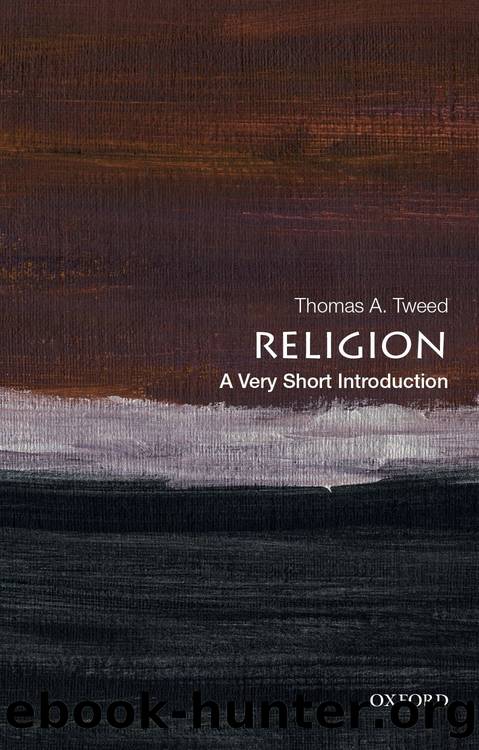Religion: A Very Short Introduction by Thomas A. Tweed

Author:Thomas A. Tweed [Tweed, Thomas A.]
Language: eng
Format: epub
Tags: Religion, General, history, Comparative Religion
ISBN: 9780190064693
Google: 7f3-DwAAQBAJ
Publisher: Oxford University Press
Published: 2020-09-25T00:31:20.437551+00:00
Conclusion
Religions, sects, and NRMs have created distinct institutions, like the LDS Church, but religious practice has been mediated by the technologies that the devout employ as well as the institutions they organize. We can see the mediating power of technologies and institutionsâand note institutional splitsâby reconsidering the BÄmiyÄn cave-temple complex, where yellow-robed Buddhist monks once gathered in a monastery and used ancient communication technology to write Sanskrit texts on palm leaves.
In that valley along the Silk Road route to China, India, and Persia, and beneath the two cliff-dwelling Buddhas, a thousand monks lived out their faith amid the aroma of incense and the sound of chanting. In the monasteries below, early sectarian divisions were evident. The BÄmiyÄn monks aligned themselves with the LokottaravÄdin school, which arose during Buddhismâs first schism. That early debate concerned the proper religious ideal. It focused on whether the arhat, a person who has achieved enlightenment, is perfect. The monastic order at BÄmiyÄn descended from those who challenged the arhat ideal affirmed by the other original Buddhist schools, which their opponents would call the HÄ«nayÄna, or âLesser Vehicle.â They decided that those who achieve liberation are fallible. That opened a slight gap between humans and buddhas, and it led to the development of the MahÄyÄna, those who called themselves the âGreater Vehicle.â That major Buddhist branch, which dominated East Asia, proposed an alternative ideal: the wise and compassionate bodhisattva, who renounces his own liberation to save all beings. They also venerated buddhas as supernatural agents with wondrous powers, a view already expressed in the MahÄyÄna texts stored in the library at BÄmiyÄn and hinted at in the cave templeâs sculpture and murals, including those colossal Buddhas. So those BÄmiyÄn monks, who gathered in monasteries and wrote on palm leaves, were the inheritors of one institutional split and forerunners of another.
7. An 1834 engraving of the Buddhas in BÄmiyÄn, Afghanistan, shows how the statues looked before they were destroyed. The people and camels at the base of the larger Buddha, which was about 175 feet tall, give some sense of their monumental size.
Download
This site does not store any files on its server. We only index and link to content provided by other sites. Please contact the content providers to delete copyright contents if any and email us, we'll remove relevant links or contents immediately.
Machine Learning at Scale with H2O by Gregory Keys | David Whiting(3654)
Never by Ken Follett(3545)
Fairy Tale by Stephen King(2961)
The Man Who Died Twice by Richard Osman(2818)
Reminders of Him: A Novel by Colleen Hoover(2779)
Will by Will Smith(2589)
Rationality by Steven Pinker(2156)
It Starts With Us (It Ends with Us #2) by Colleen Hoover(2053)
Friends, Lovers, and the Big Terrible Thing by Matthew Perry(2012)
Can't Hurt Me: Master Your Mind and Defy the Odds - Clean Edition by David Goggins(2008)
The Stranger in the Lifeboat by Mitch Albom(1943)
The Becoming by Nora Roberts(1926)
Love on the Brain by Ali Hazelwood(1824)
New Morning Mercies: A Daily Gospel Devotional by Paul David Tripp(1816)
HBR's 10 Must Reads 2022 by Harvard Business Review(1702)
The Strength In Our Scars by Bianca Sparacino(1701)
A Short History of War by Jeremy Black(1677)
Never Finished: Unshackle Your Mind and Win the War Within by David Goggins(1562)
515945210 by Unknown(1524)
